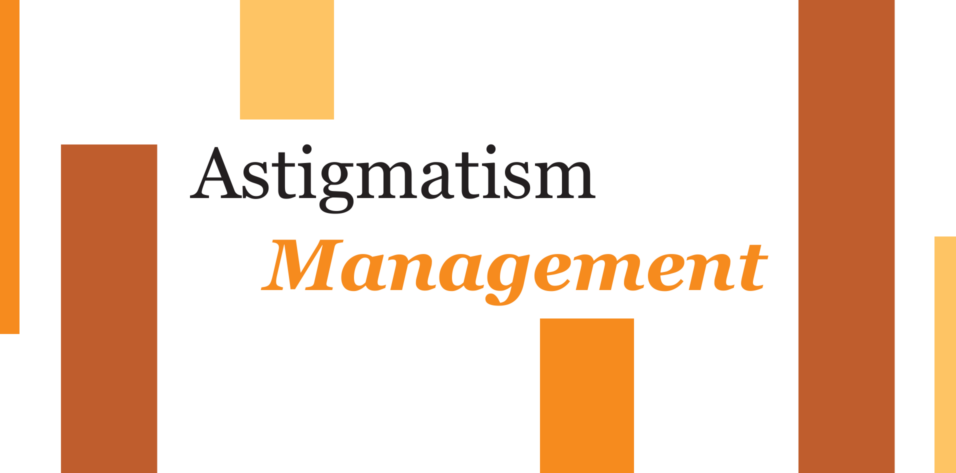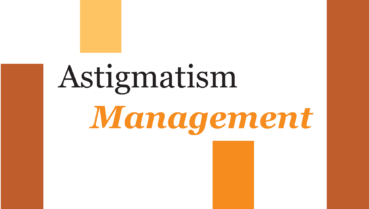
One quite often hears bad advice being promulgated concerning the use of toric IOLs through non–peer-reviewed sources and at conferences. This article lays out my evidence against some of these myths, including a few that contain a grain (or two) of truth.
MYTH NO. 1: NEVER FLIP THE AXIS
A frequently heard piece of advice is never to flip the axis with a toric IOL. Flipping the axis refers to an overcorrection of the eye’s predicted astigmatism after removal of the crystalline lens. The predicted astigmatism is mostly corneal in origin but may have other sources.1 Overcorrection of this astigmatism by a toric IOL on the correct axis rotates the postoperative refractive astigmatism 90º from the axis of the preoperative corneal astigmatism—flipping the axis, so to speak.
The ubiquity of this myth has motivated many manufacturers to add a warning to their online toric IOL calculators when an overcorrecting IOL cylinder is chosen. There is, however, no logic to support the maxim. The advice never to flip the axis with a toric IOL has its roots in optometrists’ experiences with spectacle overcorrection of refractive astigmatism. Astigmatism-correcting spectacles cause varying degrees of magnification along different meridians. The wearer habituates to one pattern of meridional magnification. If the pattern is shifted 90º by an overcorrecting spectacle lens, the wearer experiences discomfort. The varying meridional magnification produced by toric IOLs is minor by comparison, so toric IOL patients are not troubled by a so-called flipped axis.2
Not only are the effects of flipping the axis with a toric IOL not perceived by patients, but overcorrection could be desirable. Toric lenses come in refractive steps, both sphere and cylinder. The cylinder power rarely matches the astigmatic requirement of the eye exactly. The astigmatic outcome is therefore almost never zero, so ophthalmologists choose the nonzero target they prefer. A surgeon who habitually undercorrects astigmatism, even for patients who could benefit from overcorrection, misses an opportunity to minimize their postoperative refractive astigmatism and maximize their spectacle independence. Instead, the mean amount of residual refractive astigmatism likely increases from approximately 0.50 to 0.80 D (almost double) in this situation.3
My advice is to flip the axis with a toric IOL if overcorrection is likely to leave a patient with less postoperative refractive astigmatism.
MYTH NO. 2: OPERATE ON THE AXIS
The flattening effect of a cataract incision can reduce the amount of postoperative corneal astigmatism. Intentionally employing this effect is a good idea, particularly if there is no better management option in a case and the amount of preoperative corneal astigmatism is low. The flattening effect of the incision through which the cataract is removed and the IOL is implanted is proportional to the wound arc length and inversely proportional to the distance of the arc from the center of the cornea. A superiorly placed incision has a greater flattening effect than a horizontally placed incision because the cornea is oval and its smallest diameter is vertical.4
The problem with this myth lies in the unpredictability of both the axis and power of cataract incisions.5 Surgically induced astigmatism is calculated as the vector difference between pre- and postoperative keratometric astigmatism, power, and axis. Keratometric power and axis values are prone to test-to-test variation.6 This is obvious in eyes with low corneal astigmatism and makes predicting the effect of surgical astigmatic treatment difficult. When prediction accuracy is low, the therapeutic effect from surgically induced astigmatism is uncertain but might be used in the absence of a better option.7,8 The relatively larger incision for manual small-incision cataract surgery may also be useful; larger incisions are generally more predictable in effect.9
Operating on the steep corneal axis can be ergonomically challenging in some eyes. Moreover, the range of astigmatism that can be addressed by an on-axis incision is small. The effect can be augmented by placing opposite clear corneal incisions on the steep meridian. Limbal relaxing incisions combined with astigmatically neutral phaco incisions can be even more powerful.5 The most powerful and accurate technique for reducing preoperative astigmatism, however, is a toric IOL.10
MYTH NO. 3: RESIDUAL ASTIGMATISM CAN IMPROVE VISUAL FUNCTION
Just 0.25 D of astigmatism can affect vision, as patients can attest when different 0.25 D cylinder steps are used in a trial frame. Theoretically, residual refractive astigmatism could benefit a patient in certain circumstances. For example, the blur circle produced by a small amount of astigmatism could increase depth of field. That said, the patient would still have a blur circle.
The ideal amount of astigmatism is undefined but is probably zero. In clinical practice, patients find zero astigmatism provides the greatest degree of spectacle independence. With their set cylinder steps, toric IOLs rarely leave a patient with zero refractive astigmatism. Surgeons can therefore minimize but not eliminate most patients’ astigmatism.
Corneas change as they age, and the steep axis tends to drift from with the rule (WTR) to against the rule (ATR).11 With this in mind, some cataract surgeons leave patients with a small amount of WTR astigmatism because, in time, it will diminish and their unaided visual acuity should improve as the axis of astigmatism shifts.12 I have two philosophical objections to this strategy. First, not every eye experiences a drift to ATR astigmatism. A small residual amount of WTR astigmatism is a disadvantage in this situation. Second, many routine cataract surgery patients have already experienced the axis shift, and others may not live long enough after surgery to reap the benefit of a future axis shift. I find that patients appreciate good unaided vision as early as they can achieve it after surgery, so I focus on minimizing the astigmatism they currently have.
MYTH NO. 4: TORIC IOLS SHOULD NEVER BE IMPLANTED IN AN EYE WITH AN IRREGULAR CORNEA
This myth holds more than a grain of truth. When fitted on an eye with an irregular cornea, rigid gas permeable (RGP) contact lenses provide a regular refracting surface and a lacrimal lens (ie, the tears that lie between the contact lens and the cornea). The close refractive indices of the RGP lens, tears, and cornea produce a uniform refractive element and nearly normal paraxial optics. Lenticular astigmatism, if present, is not corrected. The amount in most eyes, however, is relatively minor. If a patient with irregular astigmatism can tolerate an RGP contact lens, they should therefore benefit from the enhanced quality of vision it provides.
Most corneas with irregular astigmatism have a component of regular astigmatism. If a substantial amount of the corneal irregularity can be characterized as coma, it can be reasonably corrected by a standard toric IOL. In essence, coma masquerades as regular astigmatism. Sometimes, the quasi-regular component of an eye’s irregular astigmatism can be corrected by spectacles to a beneficial extent. For instance, many patients with keratoconus can see well with regular toric spectacles. In such cases, there is reason to believe the same effect can be achieved by a toric IOL.
A problem arises, however, if the remaining corneal irregularity prevents the patient from achieving adequate visual acuity with a toric IOL.
Is it reasonable to implant a toric IOL in an eye with an irregular cornea if an RGP contact lens may be required after surgery? Traditional teaching says no because the RGP contact lens and its lacrimal lens correct both the regular and irregular astigmatism, rendering the toricity of the IOL redundant to the cornea and contact lens refracting optical system. The toric IOL astigmatism becomes manifest in the spectacle refraction. In a keratoconic eye, for instance, the toric IOL could have substantial cylinder.
My approach to astigmatism correction in irregular corneas such as eyes with keratoconus is more nuanced. If these patients have tolerable acuity and good overall visual function with astigmatism-correcting spectacles, a well-chosen toric IOL can be equally beneficial. I feel comfortable implanting these lenses in patients with mild disease and those who have achieved stability after CXL, especially if they have a history of spectacle use rather than RGP contact lenses.
The challenge is that the presence of a cataract complicates spectacle correction in patients with a history of RGP contact lens use. Patients seeking clear lens extraction are easier to judge because the quality of their spectacle vision can be assessed in the absence of cataract.
If visual quality after toric IOL implantation in eyes with irregular corneas is poor, an IOL exchange for a spherical lens can be performed. An easier approach to correct for the IOL toricity is to prescribe a toric RGP contact lens.
Theoretically, an alternative is to implant a piggyback IOL in the sulcus. The toricity, axis, and power of the lens appropriately chosen could neutralize the toricity of the IOL in the bag, returning the eye to its preoperative astigmatic state. The secondary IOL would have essentially the same cylinder power, adjusted for effective lens position, as the toric IOL in the capsular bag but at 90º to it. The patient may then resume wearing an RGP contact lens. As a bonus, the spherical equivalent power of the secondary IOL could be adjusted to correct residual spherical equivalent error. I have never encountered this situation or used this strategy but would be interested in hearing from anyone who has.
CONCLUSION
Debunking common myths surrounding toric IOL use can help more cataract patients achieve a better quality of vision.
1. Hoffmann PC, Auel S, Hütz WW. Results of higher power toric intraocular lens implantation. J Cataract Refract Surg. 2011;37(8):1411-1418.
2. Beheregaray S, Goggin M, LaHood B. Astigmatic overcorrection and axis flip for targeting minimal remaining refractive astigmatism with toric intraocular lenses. J Cataract Refract Surg. 2018;44(1):109-110.
3. Goggin M, LaHood BR, Roggia MF, Chen TS, Beheregaray S, Esterman A. Leftover astigmatism: the missing link between measured and calculated posterior corneal astigmatism. J Refract Surg. 2022;38(9):559-564.
4. Hashemi H, Khabazkhoob M, Soroush S, Shariati R, Miraftab M, Yekta A. The location of incision in cataract surgery and its impact on induced astigmatism. Curr Opin Ophthalmol. 2016;27(1):58-64.
5. Kaufmann C, Peter J, Ooi K, Phipps S, Cooper P, Goggin M; Queen Elizabeth Astigmatism Study Group. Limbal relaxing incisions versus on-axis incisions to reduce corneal astigmatism at the time of cataract surgery. J Cataract Refract Surg. 2005;31(12):2261-2265.
6. Goggin M, Patel I, Billing K, Esterman A. Variation in surgically induced astigmatism estimation due to test-to-test variations in keratometry. J Cataract Refract Surg. 2010;36(10):1792-1793.
7. Khokhar S, Lohiya P, Murugiesan V, Panda A. Corneal astigmatism correction with opposite clear corneal incisions or single clear corneal incision: comparative analysis. J Cataract Refract Surg. 2006;32(9):1432-1437.
8. Borasio E, Mehta JS, Maurino V. Torque and flattening effects of clear corneal temporal and on-axis incisions for phacoemulsification. J Cataract Refract Surg. 2006;32(12):2030-2038.
9. Boramani J, Bali J, Boramani P, Bali O. Customized incision cataract surgery: astigmatism modulation techniques in manual small-incision cataract surgery. Indian J Ophthalmol. 2022;70(11):4032-4035.
10. Goggin M, van Zyl L, Caputo S, Esterman A. Outcome of adjustment for posterior corneal curvature in toric intraocular lens calculation and selection. J Cataract Refract Surg. 2016;42(10):1441-1448.
11 Liu YC, Chou P, Wojciechowski R, et al. Power vector analysis of refractive, corneal, and internal astigmatism in an elderly Chinese population: the Shihpai Eye Study. Invest Ophthalmol Vis Sci. 2011;52(13):9651-9657.
12. Koch DD, Jenkins RB, Weikert MP, Yeu E, Wang L. Correcting astigmatism with toric intraocular lenses: effect of posterior corneal astigmatism. J Cataract Refract Surg. 2013;39(12):1803-1809.


